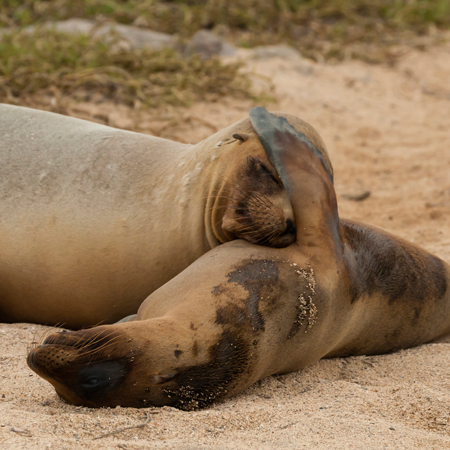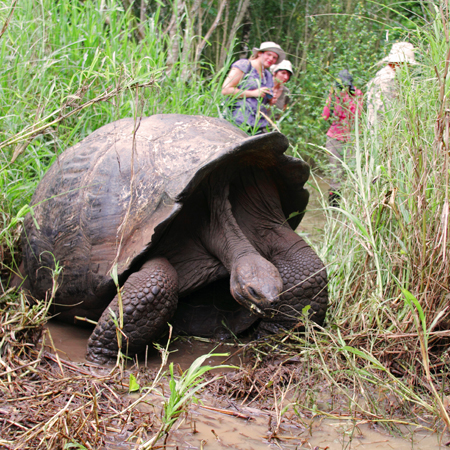Galápagos Seasons
A question we often hear is, “what is the best time to visit the Galápagos?” That sounds like an easy question, but the answer depends on what you’d like to do and see. The islands have a subtropical climate with two main seasons. The land and sea temperatures are affected by currents such as the cold Humboldt and the warmer El Niño. Each season provides an array of activities from snorkeling to watching mating rituals.
The Warm Season (December–May)
This is the warmest time of year and receives slightly more rainfall. The sea is at its warmest and is usually calmer. Although the islands receive more rain, the lower elevations of the islands—where you will spend most of your trip—offer blue skies and sunshine with occasional haze.
The Cool Season (June–November)
The drier garua season offers plenty of sunshine during the day, but it is less intense, with cloudier skies. Air temperature is lower, with highs in the upper 70s or mid-80s. The water temperature is at its coolest. During some years, the El Niño current may cause a much greater flow of warm waters, making the surface warmer and rainfall increase.


Average Conditions & Animal Activity By Month (GALAPAGOS TURTLE ACTIVITY)
January:
Beginning of the rainy season, ideal time for snorkeling and calmest water. Land birds start nesting, generally after the first rain. On Española the adult male marine iguanas become brightly colored. The green sea turtle arrives in the Galápagos Islands to lay their eggs on beaches. Land iguanas begin reproductive cycles on Isabela.
February:
Flamingos start nesting on Floreana. Bahamas pintails start their breeding season. Masked boobies on Española are at the end of their nesting season. Marine iguanas nest on Santa Cruz. Penguins may be sighted at Bartolomé. The nesting season of the Galápagos dove reaches its peak.
March:
Height of the rainy season. Sporadic tropical rains, intense sun and hot climate. Marine iguanas nest in Fernandina. March 21, the beginning of the summer equinox, signals the arrival of the waved albatross to Española.
April:
Massive arrival of waved albatross to Española. Their courtship starts. Hatching season ends for giant tortoises. The eggs of the green sea turtles begin to hatch. Land iguanas hatch on Isabela.
May:
North Seymour’s blue-footed boobies begin their courtship. Galapagos sea turtles are still hatching on Gardner Bay, Punta Cormorant, and Puerto Egas. Most of the marine iguanas eggs hatch from nests on Santa Cruz. Palo Santo trees begin to shed their foliage. Albatross on Española start laying their eggs. Storm petrels begin their first nesting period.
June:
Beginning of the garua season (cooler and drier climate). Giant tortoises on Santa Cruz migrate from the highlands to the lowlands in search of suitable nesting places. Beginning of the nesting season of giant tortoises.
July:
Sea bird communities are very active, especially the Blue Footed boobies on Española. Flightless cormorants court and nest on Fernandina. Oystercatchers start nesting at Puerto Egas. Lava lizards initiate mating rituals until November. Whales are likely to be observed, especially off the Western coast of Isabela.
August:
The Galápagos hawks court on Española and Santiago. Mask boobies and swallow-tailed gulls nest on Genovesa. Migrant shore birds begin to arrive on the islands and remain until March. Giant tortoises return to the highlands of Santa Cruz.
September:
Cold season peak (with an average temperature of 72°F. ). Whale sightings more common. Penguins demonstrate remarkable activity on Bartolomé until December & sea lions are very active. Most marine birds remain active at their nesting sites.
October:
Lava herons nest until March. The Galápagos fur seals begin their mating period. Boobies raise their chicks on Española. Giant tortoises still lay their eggs.
November:
Sea lion pups are born. Sea lions are sexually active on the Eastern part of the Archipelago. Breeding season of brown noddies. Storm petrels begin their second nesting period.
December:
Hatching of the giant tortoise’s eggs begins and lasts until April. Green sea turtles display their mating behavior. The rainy season begins and all of the plants of the dry zone produce leaves and the Galápagos “turn green.”
More Galápagos Information
Our experts are happy to answer your questions and can be reached by email or by phone (888-570-7108).

